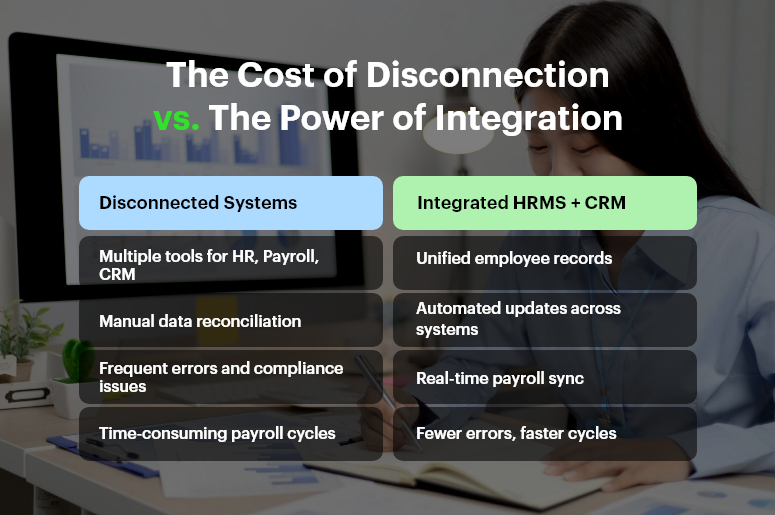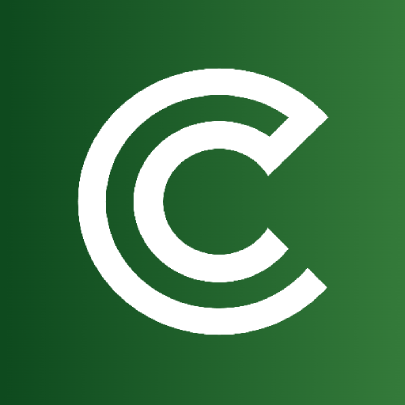Are you still juggling spreadsheets, separate HR tools, and standalone payroll software? You’re not alone—many growing businesses rely on disconnected systems to manage their people and payroll. But this often results in errors, inefficiencies, and compliance headaches. According to a report by KPMG, 47% of HR leaders cite integrating HR systems with payroll as one of their biggest challenges.
That’s where an integrated HRMS (Human Resource Management System) comes in. In this blog, you’ll learn why aligning your HR and payroll under one unified system is not just a smart move — it’s essential for scaling your business efficiently.

Why People and Payroll Must Work Hand-in-Hand
As your workforce grows, so do your HR and payroll complexities. Managing multiple systems leads to data duplication, miscommunication, and payroll delays — problems that directly impact employee satisfaction and financial accuracy.
With an integrated HRMS, your business benefits from:
- Centralized Employee Data: From onboarding to benefits and time tracking, all employee information lives in one place, eliminating manual re-entry and the risk of conflicting data.
- Accurate and Timely Payroll: Employee roles, attendance, leaves, and benefits are automatically synced with payroll — no more month-end scramble.
- Compliance Made Easy: Tax deductions, labor laws, and statutory filings are easier to manage when your HR and payroll are synced under one roof.
Real-World Relevance Across Industries
- Retail & FMCG: High employee turnover and shift scheduling can cause payroll chaos. An integrated HRMS automates these processes for real-time accuracy.
- Construction & Field Services: Managing timesheets, project-based wages, and contractual labor becomes seamless.
- Tech & Startups: Fast-growing teams need agile systems. Unified HR-payroll platforms reduce overhead while boosting scalability.
Best Practices & Actionable Tips
How to Keep HR & Payroll in Sync Using an Integrated HRMS
Here’s how to make the most of your HRMS and ensure people operations and payroll are always aligned:
Automate Employee Lifecycle Events
Every employee event — hiring, promotions, exits — should automatically update payroll records. Promotions should trigger new salary bands, and exits should calculate final settlements without delay.
Sync Time Tracking and Leave Management
Track attendance, remote hours, and leave requests in real-time. This ensures payroll reflects the actual hours worked or days off taken—cutting down on disputes and errors.
Implement Role-Based Access Control
Maintain data confidentiality by giving the right access to the right people. Managers can approve leaves; HR can update records; Finance can process payroll — without stepping on each other’s toes.
Automate Statutory Compliance
Auto-generate PF, ESI, TDS, and tax reports with up-to-date rules. This minimizes human error, keeps you audit-ready, and saves hours of manual calculations.
Set Payroll Cut-off Dates & Auto-Schedule Runs
Define cut-off dates and run payroll on a fixed schedule. This ensures everyone gets paid on time, even if HR is managing other tasks.
Integrate Direct Bank Transfers
Disburse salaries through secure, integrated banking channels. This reduces the need for manual uploads and improves payment security.
Track Payroll Costs by Department or Project
Assign salary expenses to specific projects, teams, or departments. This gives you better budget visibility and allows for data-driven financial decisions.
Deliver Payslips and Tax Forms Automatically
Let your HRMS generate and email payslips and Form 16s. Employees can access their records any time, improving transparency and trust.
Enable Self-Service Portals for Employees
Empower employees to access payslips, update KYC, and view leave balances on their own. This reduces back-and-forth emails and saves time for both HR and staff.
Link CRM + ERP with HRMS for Complete Visibility
Unify your people, sales, and financial data in one platform like CRMLeaf. When your CRM + ERP and HRMS work together, you gain full operational transparency.
Customer Success
For example, Apex Solutions, a mid-sized logistics firm, used CRMLeaf’s integrated HRMS to bring their payroll, attendance, and leave tracking into one system.
Previously, they faced recurring payroll errors due to manual attendance reconciliation. After the switch:
- Payroll processing time was reduced by 40%.
- Employee disputes dropped by 60%.
- Compliance reports were generated in minutes instead of days.
With CRMLeaf, Apex saw higher employee satisfaction and fewer administrative burdens.
Key Takeaways & Closing
An integrated HRMS is more than a convenience — it’s a strategic necessity. When your people and payroll data sync automatically, your business runs smoother, faster, and more compliantly.
By removing silos, automating critical processes, and boosting employee trust, you position your business for scalable growth and operational excellence.


